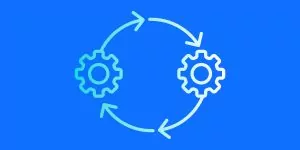The way we do work today isn’t working for many employees and employers. Employers have fewer qualified people to perform complex tasks, while employees get bogged down with low-value tasks. What slowly emerges is a productivity crisis. How can companies solve it?
Automation is one of the go-to solutions, but automation fixes are still segmented, focusing on improving isolated parts of a process versus the whole process as part of an outcome-focused automation strategy. This is where deep deployment of automation technologies comes in.
What is digital process automation for deep deployments?
Deep deployments target the seamless orchestration of whole processes, traditionally associated with business process automation (BPM), at a cross-enterprise level, while solving long-tail challenges with simple business applications in order to improve productivity and end-to-end customer or employee experiences.
To see how deep deployments of automation could impact productivity, take a typical loan officer. Currently, she spends most of her time on low-value tasks like inputting data from documents and generating reports. If her workload is augmented by automation, she can focus on higher-value work like building relationships with clients or finding new business opportunities.
To achieve the type of business outcome that helps our loan officer, deep deployments require a broader set of automation technologies beyond traditional workflow or BPM. To go deeper, it’s helpful to understand such concepts as decision automation, content management, intelligent capture, robotic process automation (RPA) and the effects of AI and machine learning. For this reason, pragmatic enterprises often seek out automation platforms that provide a full spectrum of capabilities in order to address the many opportunities and challenges driving productivity, now and in the future.
What’s new in deep deployments?
AI and machine learning. These technologies are emerging as a natural next step for improving productivity by optimizing workstream automation. As operational data becomes more accessible to organizations, AI and machine learning algorithms can find automation patterns for offloading low-value tasks to technology, freeing employees to focus on high-value work, and patterns for assisting them in higher-value, expert work. For example, AI-enabled digital agents can extract and classify unstructured data in documents and make certain insights or recommendations available to employees.
Low code builder tools. For automation to be successful at scale, users should also be able to solve productivity problems with minimal IT involvement. Low code builder tools put the ability to create automated business applications in the hands of the business users, allowing IT to focus on creating reusable automation patterns that support it. As an example, the loan officer from the above example may have a business app that is created to automatically approve loans below certain criteria. If there is a sudden change in risk appetite, she can quickly and easily adjust criteria without the need for IT involvement.
How are deep deployment solutions evaluated?
Forrester Research recently evaluated 10 vendors on their digital process automation for deep (DPA Deep) deployments options to help application development and delivery professionals select the right provider for their needs. In their report, The Forrester Wave: Software for Digital Process Automation for Deep Deployments, Q2 2019, IBM was named a leader.
According to the Forrester report, “IBM has consolidated its content management, decision management, and process automation offerings under a single executive and engineering team with a unified go-to-market execution. At the same time, it has done some of the most pragmatic integration of IBM’s Watson AI capabilities to drive very process-specific business value. The result is a highly integrated solution well-tuned for handling deep processes.” Additionally, “IBM has a strategy to extend its process and case management platform to enable more of the generalized low-code development that more extensive DPA often requires.”
IBM Business Automation Workflow, which was evaluated by Forrester in the report, is part of the IBM Automation Platform for Digital Business. Our platform enables clients to automate workflows and decisions while deriving insight from the content within those business processes with speed and at scale. IBM clients have created and are running more than 50,000 applications on this platform as they seek to improve productivity and customer experiences.
Register to get the full Forrester report comparing software for digital process automation for deep deployments.
The post Solving the productivity crisis: Digital process automation for deep deployments appeared first on Cloud computing news.
Quelle: Thoughts on Cloud

Published by